Mariposa Grove, Yosemite NP
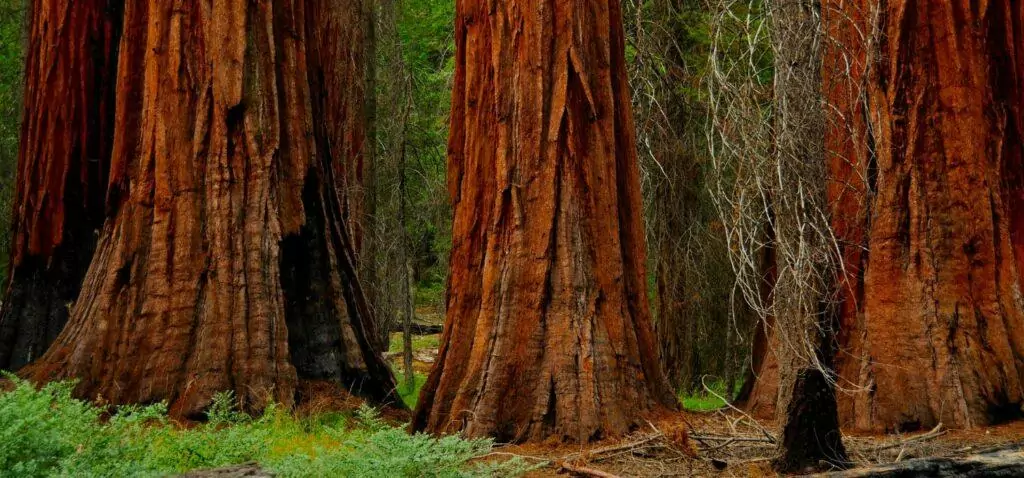
The feeling of hiking in the Mariposa Grove of Giant Sequoias is hard to put into words. Our guests have used “magical”, “monumental”, or just plain “awesome”. Boasting 500 handsome, old-growth trees, Mariposa Grove in Yosemite offers the largest stand of giant redwoods in the area. That said, if there was only one tree, the 2,200-year-old Grizzly Giant, the trip would be worth it!
It doesn’t matter whether you take the easy or the more difficult Mariposa Grove trails, you will gawk and photograph scores of stately giant redwoods. Besides the Grizzly Giant, other tree celebrities on this sequoia hit parade are the Fallen Monarch, Bachelor and Three Graces, Faithful Couple and the California Tunnel Tree.
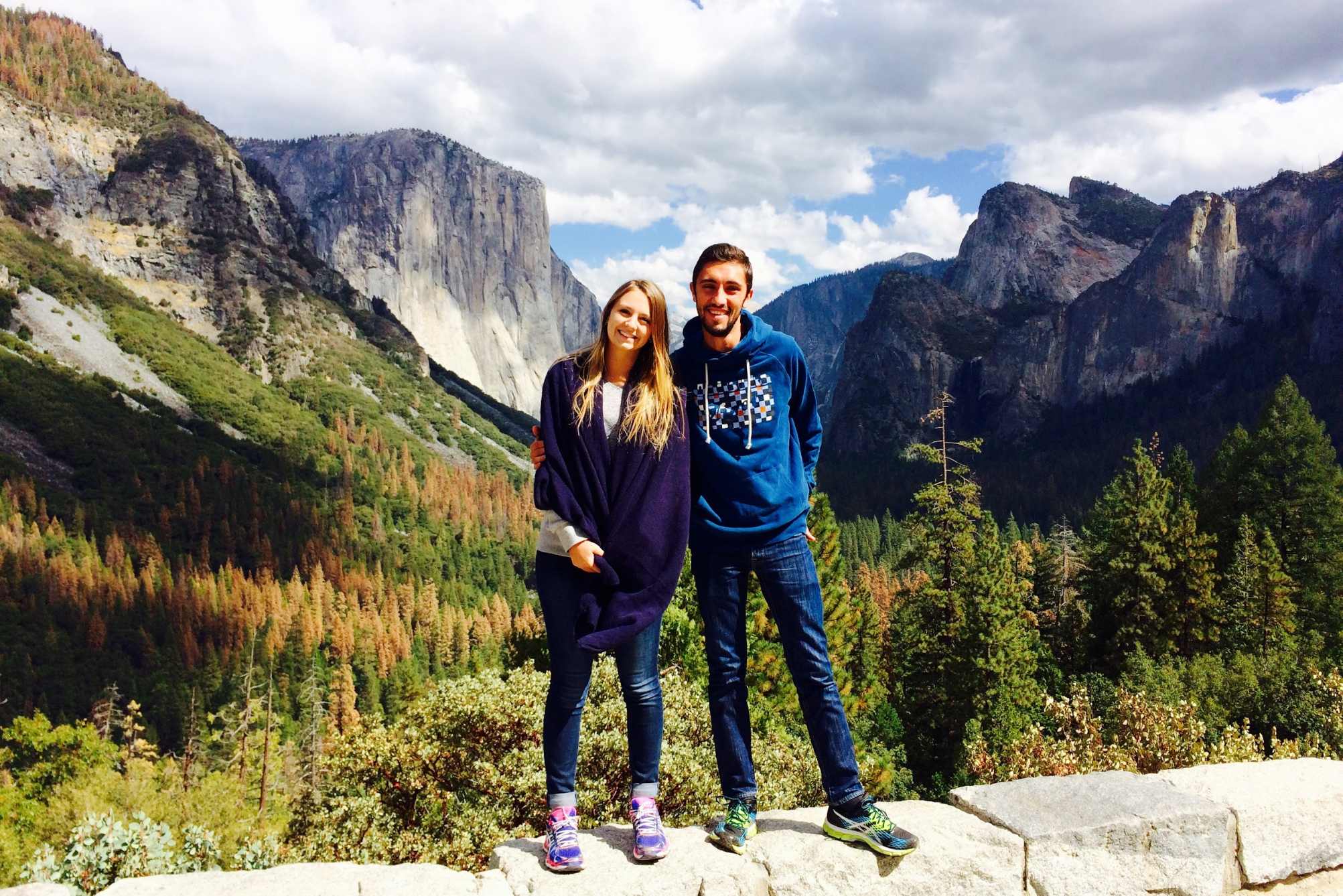
Yosemite and Giant Sequoias One Day Tour from San Francisco
The only 1-day Yosemite National Park tour from San Francisco to deliver more than you dreamed at Half Dome, El Capitan, Yosemite Falls, and on a hike to Giant Sequoias.

Exclusive Muir Woods, Napa & Sonoma Valley Wine Tour
The only wine country tour to combine three Napa & Sonoma Valley wineries with a morning excursion to San Francisco’s stunning Coast Redwood forest – Muir Woods.
As you plan your trip to the Mariposa sequoia grove, use this page to get the inside scoop on:
- What there is to see in Mariposa Grove
- Why Giant Sequoias are so special and rare
- The famous “must-see” trees in Mariposa Grove
- Best Mariposa Grove trails for hiking
- How to get to Mariposa Grove
- Best time to visit the Giant Sequoias
- Where to stay near Mariposa Grove
- Things to know before you go
“Like lying in a great solemn cathedral, far vaster and more beautiful than any built by the hand of man.”
How President Theodore Roosevelt described a night of camping beneath the redwoods in Mariposa Grove.

What There is to Do in Mariposa Grove
The Welcome Plaza for the Mariposa Grove of Giant Sequoias is located near Yosemite’s south entrance. History was made here. In 1864, President Lincoln signed the first ever federal legislation protecting scenic natural areas for “public use, resort, and recreation.”
Mariposa Grove reopened in 2018 after a three-year restoration project to reduce the impact of visitors, roads, trails and buildings on the ecological health of the sequoias. The new facilities make for an even better visitor experience. The National Park Service did a wonderful video about the restoration project. Check it out here.
Here is our advice on the top five things to do in Mariposa Grove, including our list of best hikes.
1. See the largest and oldest trees in the world
Giant redwoods are the stars of the show in Mariposa Grove. They have inspired no less than naturalist John Muir and photographer Ansel Adams. Here is the checklist of the most famous trees to see during your visit.
Fallen Monarch. This was the first celebrity tree in the grove, even though it fell a hundred or more years before it was discovered in the 1850s. A highly publicized photograph with U. S Cavalry officers from Troop F highlights the sequoia’s shallow roots.
Grizzly Giant. You will need 50 paces to circle this Mariposa Grove heavyweight champ. The Grizzly Giant is nearly 30 feet (9 meters) in diameter at the base. Just one of its branches is bigger than any other species of tree in the area. Very likely one of the oldest trees on the planet; it was alive before the life and times of Viking Ragnar Lothbrok, Kubla Khan, or even Julius Caesar.
Fallen Wawona Tunnel Tree. In 1881, the Scribner Brothers used hand axes to cut a passageway in the tree’s enormous base that permitted horse-drawn wagons to drive right through. They were paid $75 for their job! The tree was renamed the “Fallen Tunnel Tree” after it toppled over during a snowstorm in 1969.

California Tunnel Tree. To attract visitors to the grove in 1895, a tunnel was cut through the massive tree to permit coaches to pass right through its center. Since the fall of the Wawona Tunnel Tree, it is the only living Giant Sequoia tree with a man-made tunnel.
The Bachelor and Three Graces. This is a beautiful stand of four Giant Sequoias located within an easy, short walk from the Arrival Area and main trailhead for the lower grove.
Faithful Couple. You’ll “get” the name when you see these two Giant Sequoia trees growing so close that they merged over the years to form a single massive trunk. Find the Faithful Couple on the Mariposa Grove Trail beyond the Grizzly Giant by roughly one-half mile.
Clothespin Tree. Not all giant redwoods that you can walk through need to be carved out by hand. The Clothespin Tree has a natural tunnel at its base caused by fires over the centuries. The opening is wide enough for a mid-size car to pass without touching.
Telescope Tree. All the life sustaining activity of these giant redwoods happens near the surface and in the bark of the tree. When you visit the Telescope Tree you can walk inside and see the sky above from inside the trunk!
2. See a real log cabin
Galen Clark, the first Yosemite ranger, built a small cabin in the upper grove in 1861. In earlier days, this building served as a Mariposa Grove museum and distributed information about the trees and the surrounding natural ecosystem.
3. Admire the sugar pine cones
Most visitors assume that the super-sized pine cones on the floor of Mariposa Grove must have come from the Giant Sequoias. However, giant sequoia cones are small, only 2-3 inches (6 centimeters). The large cones, some as long as 20 inches (50 centimeters) are from sugar pine trees, a far smaller tree. As with other things, please leave the sugar pine cones where you find them.
4. Watch the Chickarees

Officially, they are Tamiasciurus douglasii but this squirrel has been given many nicknames: Douglas squirrels, chickarees, pine squirrels, and pillillooeet by the Native Americans. John Muir himself described these energetic little squirrels as “without exception, the wildest animal I ever saw, — a fiery, sputtering little bolt of life.”
During the Winter, it is great fun to watch the chickarees digging up the sequoia seeds they have buried in the ground.
5. Hike the Amazing Mariposa Grove Trails
The trails in Mariposa Grove were recently renovated and are the best they have ever been. There are a good variety of trails from easy to strenuous and we describe them in detail in the next section. Here is a good map from the National Park Service of the hiking options; you can also download it here.
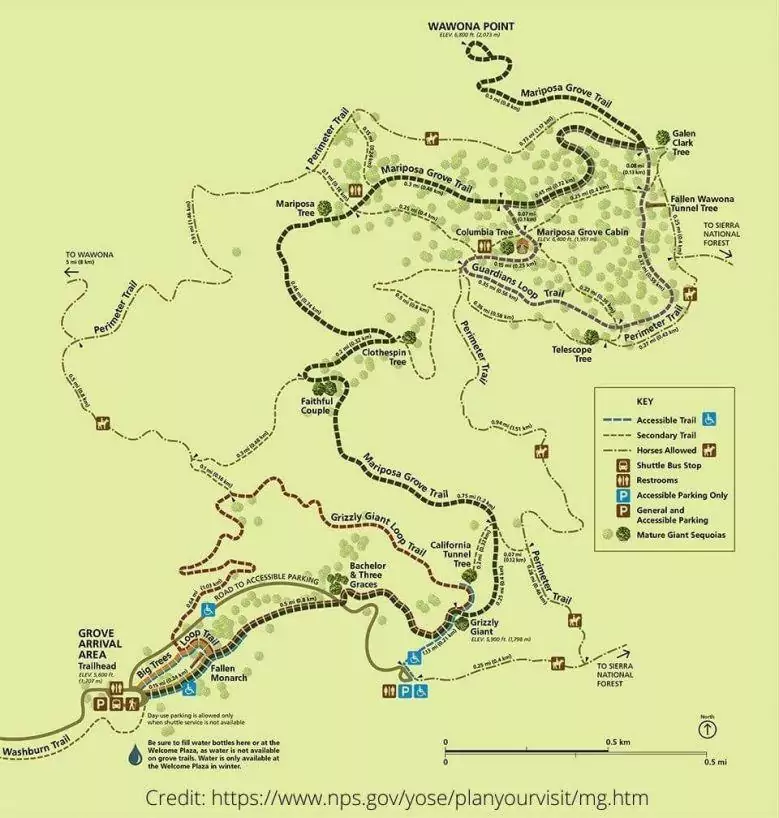
Mariposa Grove Hikes
If you stay on the trails, you are going to find some great hikes. Use the distance and duration estimates here to plan your day so you return to the trailhead in time to catch the shuttle back to the Welcome Plaza.
Big Trees Loop Trail
Difficulty: Easy
Distance: 0.3 mile (0.5 km)
Duration: 20 minutes
This short, flat trail features the Fallen Monarch and signage explaining the ecology of Giant Sequoias. If your group has young children, this is a great choice. The trail is wheelchair accessible.
Grizzly Giant Loop Trail
Difficulty: Moderate
Distance: 2 miles (3.2 km) loop
Duration: 1 ½ – 2 hours
Since it is a bit longer, this hike is classified as moderate, but it is flat the whole way. You will see some of the most famous named trees, like the Grizzly Giant, Bachelor and Three Graces, and California Tunnel Tree.
Guardians Loop Trail
Difficulty: Strenuous
Distance: 6.5-mile (10.5 km) round trip
Duration: 3-5 hours
After making a somewhat long and sometimes steep hike to the upper portion of the grove, hikers can take a 1.5-mile (2.4 km) loop to see the Mariposa Grove Cabin, Fallen Wawona Tunnel Tree, and Telescope Tree.
Mariposa Grove Trail
Difficulty: Strenuous
Distance: 7-miles (11.3 km) round trip
Duration: 4-6 hours
This trail takes hikers to see famous sequoias such as the Bachelor and Three Graces, Faithful Couple, and the Clothespin Tree. The trek up to Wawona Point overlook is steep but extremely rewarding.
Giant Sequoias Explained
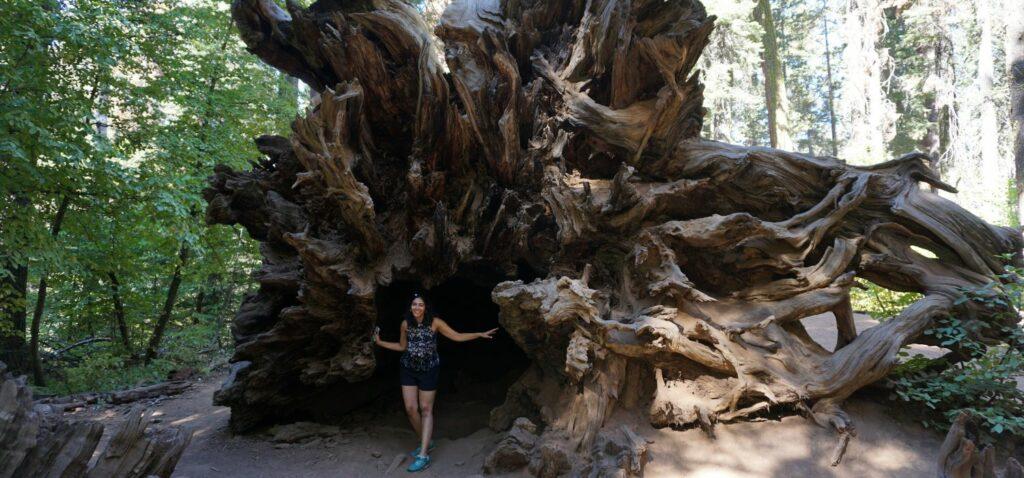
Technically speaking, these redwood giants are Giant Sequoia, a member of the Sequoioideae family which are only found above 5,000 feet (1,525 meters) on the Western slopes of the Sierra Nevada Mountains. Their cousins, Coast Redwoods, have common characteristics like distinctive cinnamon-red bark, but are taller and thrive in foggy lands nearer the Pacific Coast.
Giant Sequoias win the contest for “largest” trees on the planet. The oldest trees in these redwood forests can grow to be more than 30 feet in diameter and over 200 feet tall. The biggest of the bigs is General Sherman, which measures 102 feet (31 meters) around the base of its trunk and weighs an incredible 2.7 million pounds.
The most surprising features of these giants’ anatomy (besides the size!) is that the roots of young redwood trees go just 6 feet deep before reaching out over 100 feet and intertwining with other trees in the grove. These community-minded trees are literally holding each other up!
Another reason Giant Sequoias reach such enormous size is that they live an incredibly long time. Their 12-inch (30 centimeter), tannin-rich bark allows the trees to generally survive attacks from insects and forest fires.
How old are the Mariposa Grove trees?
Botanists calculate the age of a tree by counting annual growth rings after it has been felled. Since the rings in living trees cannot be counted, the ages given are “educated guesses”. A tree section from a 15-foot-diameter Giant Sequoia in the Mariposa Grove museum, has a ring count of 1,830 years. Since sequoias can reach up to 30 feet in diameter, it is a good bet that there have been Giant Sequoias that have lived for more than 3,000 years.
It is difficult to say precisely which is the oldest redwood tree since not all sources agree. Plus, it might be that we have not “discovered” an old growth tree in a remote area. Here is the official “unofficial record” of the five oldest living trees in the world—all Giant Sequoias.
| Location | Years | |
|---|---|---|
| 5. General Sherman | Sequoia National Park | around 2,200 years old |
| 4. Mother of the Forest | Calaveras Big Trees Park | around 2,520 years old |
| 3. Washington | Sequoia National Park | around 2,850 years old |
| 2. Grizzly Giant | Mariposa Grove | around 2,995 years old |
| 1. President | Sequoia National Park | around 3,200 years old |
Fun fact: Giant Sequoias are more prolific wood producers in old age than when they were younger. A redwood tree’s leafy branches expand over its long life. More leaves mean more sugars are created through photosynthesis, adding wood and bark to the tree’s waistline.
We could say a lot more about these amazing trees, but we’ll stop here and tell you how to get to Mariposa Grove and experience them for yourself!

Getting to Mariposa Grove
Before setting out to the Mariposa Grove, check local road conditions here since Highway 41 may be closed due to snow.
By private vehicle:
From all points west of Yosemite National Park, set your map guidance to the Mariposa Grove Welcome Plaza off Highway 41 at the end of Mariposa Grove Road. Note: this is just a staging area and parking lot. In order to reach the sequoia grove entrance, you will need to take the free shuttle (no reservation required) or walk 2 miles (3.2 km) on the Washburn Trail.
Note: the shuttle bus departs every 10-20 minutes and does not run during winter.
Vehicles with disability placards or license plates may take the Mariposa Grove Road up to the Grizzly Giant parking area.
By bicycle:
Bicycles are permitted on the paved portion of Mariposa Grove Road to the grove entrance until the road closes for the winter at the end of November or earlier if there is significant snowfall. Bicycles are not permitted on unpaved roads, sidewalks, boardwalks or trails.
By public transportation from Yosemite Valley:
Yosemite Area Regional Transit Service or YARTS provides public transportation to the Mariposa Grove Welcome Plaza. For schedules and departing locations, check here.
Special access in Winter:
In winter, the facilities at the Welcome Plaza are closed. Visitors can use the parking lot and access the grove with cross country skis or snowshoes. The Washburn Trail is lovely, and a snowshoe track is usually well established. Cross country skiers may find good tracks on wider Mariposa Grove Road.
Where to Stay
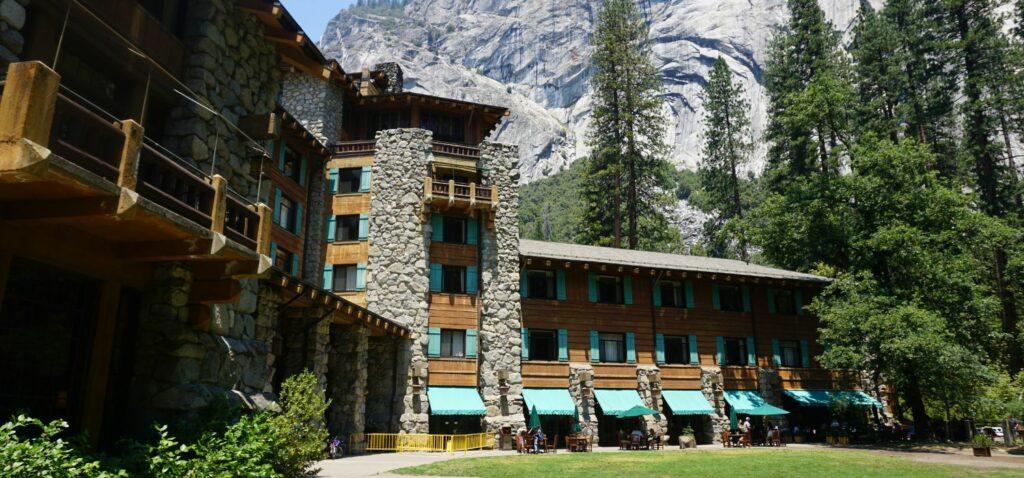
The easiest access to the Mariposa Grove is from hotels and campgrounds outside the Yosemite National Park boundaries on Highway 41. Be aware that it is a 45-60 minute trip from the grove to Yosemite Valley. If you are planning several days in Yosemite, you are probably better off to book lodging in the valley where you will have access to the park’s attractions, trails and visitor centers. If you are only planning to visit Mariposa Grove, a stay outside the park will be less expensive and more convenient.
Wawona/El Portal Lodging
Tenaya Lodge ($$$) is an upscale mountain resort with main lodge and adjacent cottages just 3 miles (5 km) from the entrance to Yosemite National Park and the Mariposa Grove staging area. The lodge organizes transportation and many activities in Yosemite park.
A Bed of Roses ($$) is bed-and-breakfast-styled lodging with views of the Sierra Nevada mountains. The location is just 11 miles (18 km) from the Mariposa Grove Welcome Plaza.
Yosemite Southgate ($) is just 1 mile (1.6 km) from the town of Oakhurst, this relaxed modern hotel is walking distance to the Yosemite Sierra Visitors Bureau. Oakhurst has nice antique shops, galleries and restaurants.
Yosemite Valley Lodging
The valley has several good options from luxury to rustic. Alert: these hotels and campgrounds are very popular so book early!
The Ahwahnee ($$$), built in 1927, is a throw-back to an earlier day and registered as an historical landmark. The decor and vibe reflect the area’s Native American influences and the historical significance of the place. Check out availability here.
Yosemite Valley Lodge ($$) is located within walking distance of Yosemite Falls, Curry Village and the YARTS shuttle (which you can take to Mariposa Grove). The lodge has rustic, cabin-like feel that blends with the wilderness setting.
Curry Village ($) offers a selection of heated and unheated tent cabins and rustic log cabins at the foot of Glacier Point. Be aware that the tent cabins do not have private bathrooms. You can also find motel-style rooms at the Stoneman House in Curry Village.
Campgrounds ($) for RVs and cars are located in Yosemite Valley. Reservations are required for the North Pines, Upper Pines, Lower Pines, and Camp 4 and a fee of $26 per day is collected at the site.
Know Before You Go
Here are few items to keep in mind as you plan your visit.
Leave your pets behind. They are not allowed on the Mariposa Grove trails or on the Mariposa Grove shuttle.
There are year-around restrooms at the Mariposa Grove Welcome Plaza, Arrival Area, Grizzly Giant, and Mariposa Grove Cabin.
Carry water. Drinking water is only available during the summer at the Welcome Plaza and Arrival Area.
Eat before arriving. There are no restaurants at the Mariposa Grove Welcome Plaza or within the Mariposa Grove. There is a nice restaurant at the Tenaya Lodge in Fish Camp.
While the Mariposa Grove Road is closed to cars from the end of November until at least March 15. When closed, the Mariposa Grove Road is open to hikers, snowshoers, and skiers.
Overnight camping is allowed from December 1 through April 15 when the Mariposa Grove Road is closed. A wilderness permit is required.
Other places to See Giant Sequoias in Yosemite
Tuolumne Grove
This stand of old-growth Giant Sequoias offers a way to enjoy the giant trees without the crowds. After a hike down a steep trail of 1.25 miles (2 km), visitors find a grove of about two dozen mature giant sequoias, including a fallen one you can walk through. Heads up: the trip back to the trailhead can be strenuous for some since there is an elevation gain of 400 feet (120 meters).
To get there from Yosemite Valley, take Highway 120 ten miles (16.8 km) to the intersection of Crane Flat and Tioga Road. Follow Tioga Road 1/2 mile (0.8 km) east and look for the Tuolumne Grove parking lot.
Merced Grove
Compared to Mariposa Grove, the Merced Grove of Giant Sequoias is quite secluded. This pleasant spot hosts 20 mature giant sequoias that can be reached after a short hike. The Merced Grove trailhead (marked by a sign and a post labeled B-10) is located on the Big Oak Flat Road (Highway 120) 4.5 miles southeast of Big Oak Flat Entrance to Yosemite.
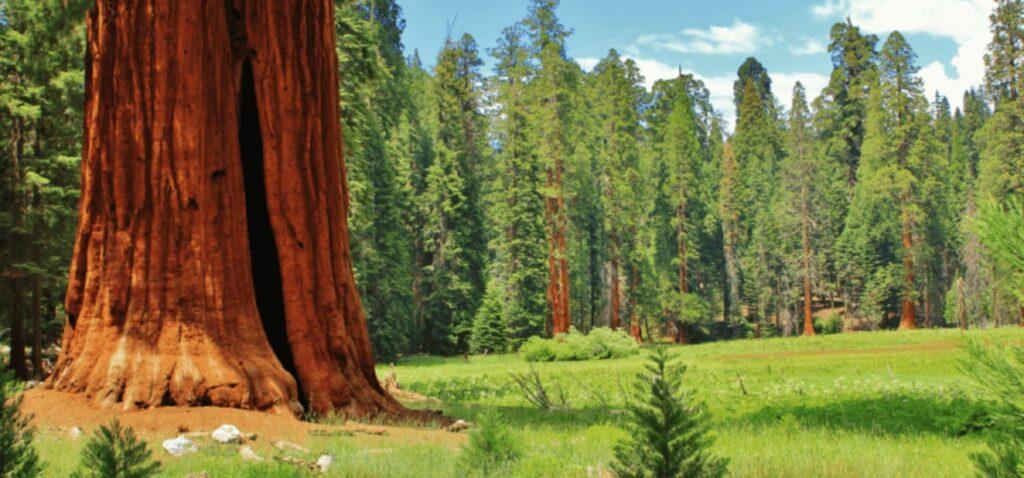
FAQs
How do you get to Mariposa Grove from Yosemite Valley?
The Mariposa Grove is located at the South Entrance to Yosemite National Park, about 45 to 60 minutes from Yosemite Village in the valley. From Yosemite Valley, take Highway 41 toward Wawona. The YARTS shuttle bus also goes to the Welcome Plaza.
How do you get to Mariposa Grove from San Francisco?
The Mariposa Grove is near the South Entrance to Yosemite. From San Francisco, set your map guidance to the Mariposa Grove Welcome Plaza off Highway 41 at the end of Mariposa Grove Road. This route will follow Highway 580 to Highway 99, then Highway 140 to Highway 41.
What is the entry fee to Mariposa Grove?
Mariposa Grove is inside Yosemite National Park and there is no separate entry fee to the grove. The entry fee for private cars into Yosemite is currently $35 per vehicle no matter how many people are in the vehicle.
What is the best time of year to visit Mariposa Grove?
Each season at Mariposa Grove offers a different experience. Summer is the best chance for sunny hikes on the Mariposa Grove trails, Fall and Spring offer trail walking with smaller crowds, Winter offers incredible photos of the trees covered in a blanket of snow.
Where do you catch the Mariposa Grove shuttle?
The free shuttle to the Mariposa Grove runs every 15-20 minutes from the Welcome Plaza. No reservation is required. The shuttle does not run from the end of November to mid-March and depends on conditions.
Is there a drive-thru tree in Mariposa Grove?
Yes. The grove is home to the California Tunnel Tree which had a coach-sized tunnel cut through its massive base in 1895. Since the 1969 fall of the Wawona Tunnel Tree, it is the only living “tunnel tree”.
What famous trees are in Mariposa Grove?
Mariposa Grove has over 500 old-growth Giant Sequoias, including some of the oldest and largest trees on earth. The “named” trees in the grove include the Grizzly Giant, Fallen Monarch, The Bachelor and Three Graces, Faithful Couple and the California Tunnel Tree.
Is Mariposa Grove open in Winter?
Yes. Mariposa Grove is open year around. However, the shuttle from the Welcome Plaza to the Arrival Area does not operate in Winter. During this time Mariposa Grove Road is closed but available to hikers, skiers and snow shoers to make their way along the 2-mile (3 km) path to the trees.